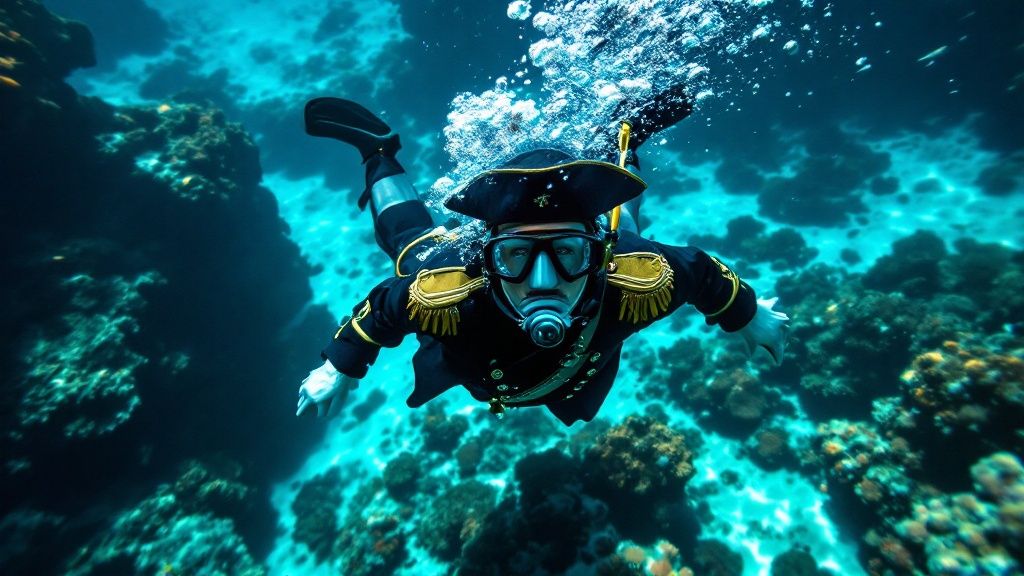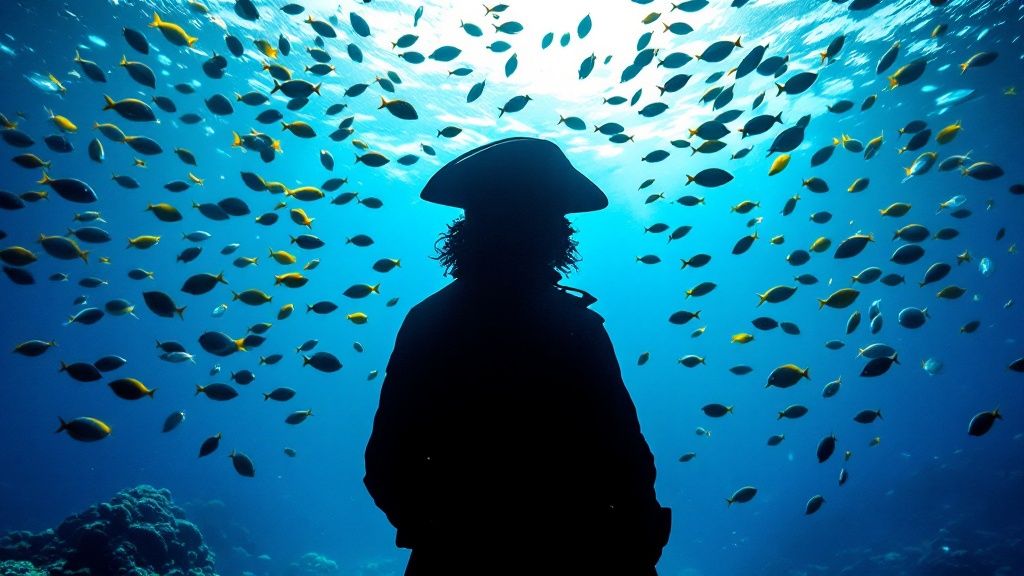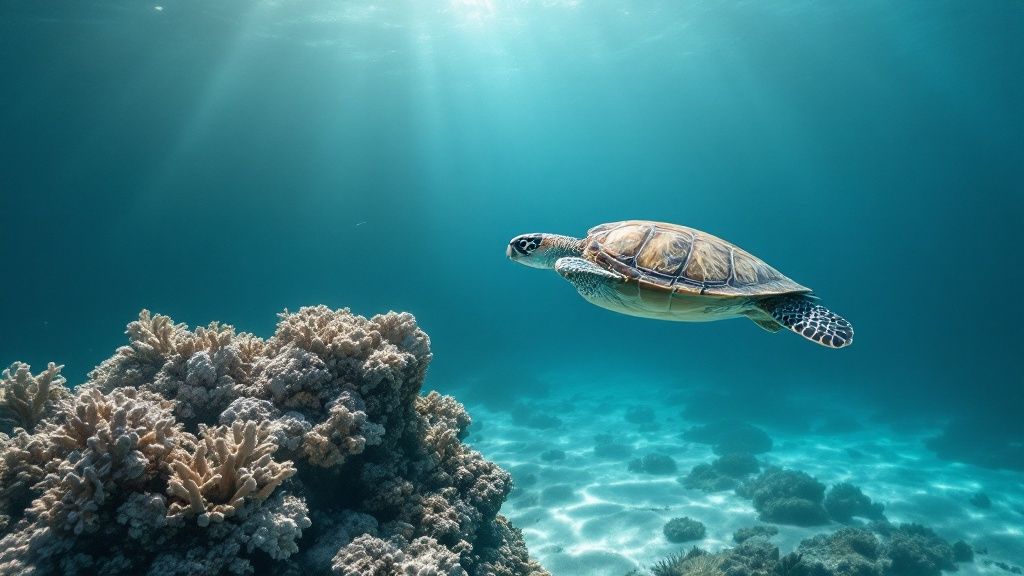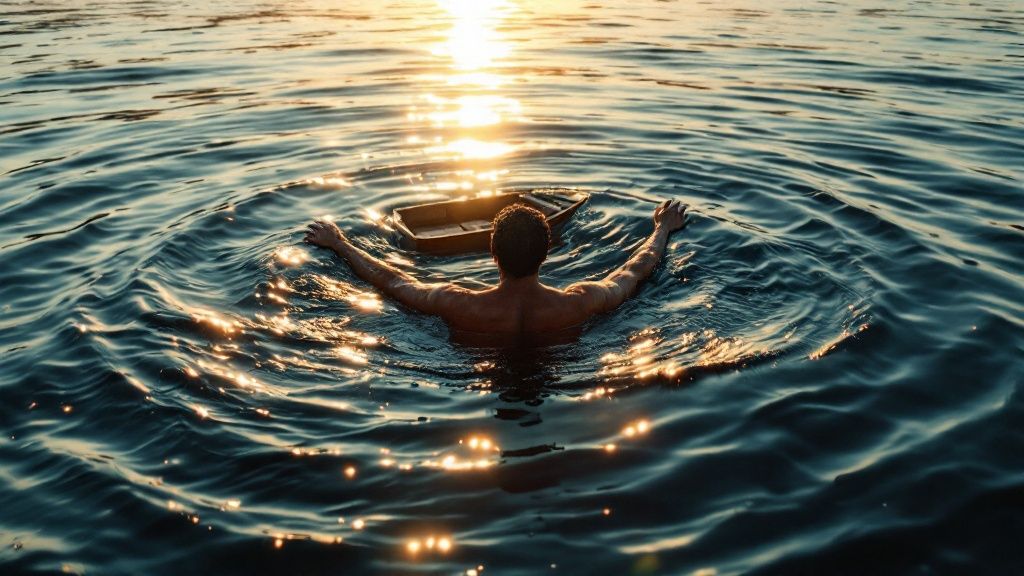Captain Cook Snorkeling: Explore Kealakekua Bay's Marine Wonders
- Kona Snorkel Trips
- Oct 3
- 14 min read
Picture this: you're floating weightlessly in calm, turquoise water. Below you, a kaleidoscope of tropical fish darts through a vibrant coral reef, and in the distance, a pod of dolphins plays. This isn't a dream—it's the heart of the Captain Cook snorkeling experience, an incredible adventure that wraps stunning natural beauty and deep historical meaning into one unforgettable package. It's so much more than just a swim; it's a journey into a true underwater paradise.
Why Kealakekua Bay Is A World-Class Snorkel Spot

Kealakekua Bay isn't just another pretty spot on the Big Island—it's a world-renowned destination where nature and history come together in a way you won't find anywhere else. The secret to its incredible condition? The bay is a protected Marine Life Conservation District. This special status shields the entire ecosystem from things like heavy fishing, allowing the underwater world to truly thrive.
The result is one of the healthiest and most pristine coral reefs in all of Hawaii. The water is usually incredibly calm and clear, with visibility often reaching up to 100 feet, making for perfect snorkeling conditions whether you're a seasoned pro or a first-timer. You're getting a front-row seat to a thriving underwater community in its most natural, untouched state.
To give you a quick rundown of what to expect, here's a look at the highlights.
Captain Cook Snorkeling at a Glance
Feature | Description |
|---|---|
Location | Kealakekua Bay, a protected Marine Life Conservation District. |
Historical Significance | The site where Captain James Cook landed in 1779 and later died. |
Water Conditions | Exceptionally calm and clear, with visibility often up to 100 feet. |
Marine Life | Healthy coral gardens, spinner dolphins, Hawaiian green sea turtles, and tons of tropical fish. |
Accessibility | Best accessed by boat, which adds to the remote and exclusive feel of the adventure. |
Key Landmark | The iconic white Captain Cook Monument, which marks the historic site. |
This unique combination of features makes a trip here unlike any other snorkeling outing.
A Sanctuary of History and Marine Life
What really makes this adventure so special is its powerful link to the past. This calm, beautiful bay is the exact spot where Captain James Cook, the first European to make contact with the Hawaiian Islands, dropped anchor in 1779. It was right here that the first major interactions between Westerners and Native Hawaiians happened—and where, tragically, Cook met his end.
As you snorkel, you are quite literally swimming through a living history lesson. Keep your eyes peeled for some of the locals:
Vibrant Coral Gardens: Look for the intricate coral structures that provide a colorful home for hundreds of species of fish.
Playful Spinner Dolphins: It's common to see pods of these acrobatic dolphins using the bay's calm waters to rest and play.
Majestic Honu (Sea Turtles): You'll often spot graceful Hawaiian green sea turtles gliding effortlessly through the water.
What Makes This Experience Unforgettable
The centerpiece of the bay is the striking white obelisk of the Captain Cook Monument, standing on the shoreline as a silent reminder of the area's incredible history. Since it's only accessible by a very tough hike or, far more popularly, by boat, arriving here feels like you've discovered a truly special and remote destination.
The experience is a fascinating blend of swimming in a real-life aquarium and visiting an open-air museum. You’re not just watching fish; you’re connecting with a place that played a pivotal role in Hawaiian history. Want to dive deeper into the local wildlife? Be sure to check out our guide to discover Kealakekua Bay’s vibrant marine life.
The Story Behind the Captain Cook Monument

As you float through the crystal-clear waters of Kealakekua Bay, a stark white obelisk on the shoreline is impossible to miss. That’s the Captain Cook Monument, and it's much more than just a landmark. It’s a silent witness to a dramatic, game-changing moment in Hawaiian history.
Knowing the story behind this monument transforms your Captain Cook snorkeling trip from a simple swim into a journey back in time. It’s a powerful tale of awe, misunderstanding, and conflict that forever altered the Hawaiian Islands.
It all started in January 1779, when British explorer Captain James Cook sailed his ships, the HMS Resolution and HMS Discovery, into the calm, protected waters of Kealakekua Bay. His timing was unbelievable—it coincided perfectly with the Makahiki festival, an ancient Hawaiian celebration honoring Lono, the god of agriculture, peace, and prosperity.
The sails on Cook's ships looked strikingly similar to the banners used in ceremonies for Lono, and the ships arrived from a direction associated with the deity. For the Native Hawaiians celebrating this sacred festival, it seemed like a prophecy fulfilled. Cook was widely believed to be Lono himself, returning as their legends foretold.
A Welcome Fit for a God
Because they thought he was a god, Captain Cook and his crew were treated with incredible reverence. They were showered with gifts, feasts, and honors usually reserved for the highest chiefs. For weeks, it was a time of peaceful and fascinating cultural exchange right on the shores of the bay. The British were stunned by the generosity, and the Hawaiians were fascinated by the visitors' strange technologies.
But this good-natured relationship was built on a massive misunderstanding. The goodwill wasn't meant to last.
After stocking up on supplies and making repairs, Cook's ships left the bay. But when a damaged mast forced a quick, unexpected return, everything had changed. The Makahiki festival was over, and the Hawaiians’ belief that Cook was Lono began to fall apart.
From Reverence to Conflict
This time, the ships were met with suspicion, not celebration. The sacred period had ended, and the locals had already generously shared many of their resources. Tensions quickly rose, climaxing when a small cutter boat was stolen from one of Cook's ships. To get it back, Cook went ashore on February 14, 1779, planning to take the high chief, Kalaniʻōpuʻu, as a hostage.
The situation spiraled out of control. A huge, angry crowd gathered on the shore, and a violent fight broke out. In the chaos, Captain James Cook was killed on the very shoreline where you can snorkel today. It was a tragic, painful end to the first major encounter between Hawaiians and the Western world, cementing Kealakekua Bay’s place in history.
The monument you see today was put up by Great Britain in 1874 to mark the spot where the famous explorer fell. It stands on a tiny piece of land that was deeded to the United Kingdom, making it a little slice of British territory on the Kona coast. As you snorkel nearby, you're floating over a site of huge cultural importance, where two very different worlds collided with world-changing consequences.
A great Captain Cook snorkeling tour doesn't just show you the amazing marine life—it shares this rich history, adding a whole new layer of depth to your adventure.
How to Choose Your Snorkeling Tour

Deciding how you’ll get to the Captain Cook Monument is a big part of the adventure. Since the monument is really only accessible by water, the boat and tour operator you pick will set the tone for your whole day. Finding the right fit is all about matching the boat style, group size, and overall vibe to what you're looking for in a Captain Cook snorkeling trip.
Lots of people love the big, stable catamarans. Think of them as floating patios—they usually have sun decks, shady spots, restrooms, and sometimes even a water slide. They offer a smooth, easy ride that’s perfect for families or anyone who just wants to kick back and enjoy the amenities.
If you're after something a bit more thrilling, you might prefer a smaller, faster rigid-hulled inflatable boat (often called a zodiac or raft). These boats sit low to the water, giving you a front-row seat to the incredible Kona coastline. Plus, they can usually zip you out to the bay faster, which means more time in the water with the fish.
What Makes a Tour Operator Stand Out
Beyond the boat itself, the crew is what really makes a trip unforgettable. When you're looking at your options, a few things signal you’re dealing with a top-notch company that takes your experience—and safety—seriously.
Small Group Sizes: A smaller group is almost always better. You get more personal attention from the guides, the boat feels less crowded, and the whole experience is just more relaxed.
Knowledgeable Guides: The best guides aren't just boat drivers; they're storytellers and marine life nerds. They can bring the history of Kealakekua Bay to life and point out all the cool fish and coral you might otherwise miss.
Commitment to Safety: You want to see a crew that's serious about safety. That means well-maintained gear, clear safety briefings, and certified staff. It's the kind of thing that lets you relax and just enjoy the day.
Marine Conservation Ethos: A good tour operator respects the bay's delicate ecosystem. They’ll teach you how to be a good guest—like not touching the coral—and follow all the rules for watching dolphins and turtles from a safe distance.
While plenty of boats cruise the Kona coast, picking one that specializes in this particular spot makes a huge difference. A dedicated tour knows the bay like the back of their hand.
The mix of stunning nature and heavy history makes these tours incredibly popular. After all, Captain Cook snorkeling is one of the top things to do on the Big Island, drawing people who want to see both a world-class marine sanctuary and the place where Captain Cook's death in 1779 marked a major turning point. That popularity means you really need to book ahead, especially during busy season.
For more tips on what to look for, you might be interested in our detailed guide to the Captain Cook snorkel tour.
Exploring the Underwater World of the Bay

The second your face slips beneath the calm surface of Kealakekua Bay, the world above just melts away. It's replaced by the quiet sounds of the ocean and an absolute explosion of life and color. This place is a Marine Life Conservation District for a reason—the ecosystem is incredibly healthy and vibrant. A Captain Cook snorkeling trip here feels less like swimming in the ocean and more like floating through a perfectly kept, massive aquarium.
The clarity of the water is something else. On a good day, you can easily see over 100 feet in every direction. That kind of visibility lets you take in the whole show, from the complex coral gardens carpeting the floor below to the shimmering schools of fish catching the sunlight from above. It’s an immersive, peaceful, and totally mesmerizing experience.
A Kaleidoscope of Reef Fish
The first thing that will hit you is the sheer number of fish. It’s a constant buzz of activity. The coral acts like a busy city for hundreds of species, and every single one adds its own splash of color to the scene.
Yellow Tangs: You can't miss them. These guys travel in big, electric-yellow schools that are an iconic sight against the blue water.
Ornate Butterflyfish: Keep an eye out for these delicate, patterned fish. They usually swim in pairs, gracefully weaving through the coral branches.
Humuhumunukunukuāpuaʻa: Try saying that three times fast! Finding Hawaii's state fish, with its unique shape and wild colors, is always a highlight for snorkelers.
Parrotfish: Listen closely. You might actually hear the gentle crunch of parrotfish using their beak-like mouths to nibble algae off the coral. They’re the reef's little gardeners, and they’re essential for keeping it healthy.
This non-stop motion and color create a living tapestry that’s incredible to witness, whether you're a seasoned snorkeler or just getting your fins wet for the first time.
Spotting Larger Marine Life
Beyond the clouds of reef fish, Kealakekua Bay is a great place to spot some larger, more elusive creatures. A little patience and a sharp eye can lead to some truly unforgettable moments.
One of the most incredible sights is seeing a honu (Hawaiian green sea turtle) glide effortlessly through the water. They are a common sight here, often found munching on seaweed or just cruising along the reef's edge. Sharing the water with one of these ancient, gentle animals is pure magic.
Quick reminder: all marine life here is protected. It's crucial to give turtles, dolphins, and any other animals you see plenty of room. Stay at least 10 feet away and never, ever try to touch or chase them. Just enjoy the view.
You might also catch a moray eel poking its head out from a rocky hideout or even an octopus camouflaged perfectly against the coral. These encounters add a real sense of discovery and mystery to your Captain Cook snorkeling adventure.
The Playful Spinner Dolphins
Kealakekua Bay is famous as a resting spot for pods of Hawaiian spinner dolphins. You’ll see them most often in the mornings, taking advantage of the calm, protected waters to chill out and socialize after a long night of hunting offshore.
While it's a huge thrill to see them from the boat, it's really important to respect their space. Federal law prohibits swimming with or getting within 50 yards of spinner dolphins to make sure they can rest without being disturbed. Watching a pod leap and spin in the distance is an absolutely breathtaking sight and the perfect way to cap off an amazing day on the water.
How to Prepare for Your Snorkeling Trip
A little prep work can be the difference between a great day on the water and a perfect one. To make sure your Captain Cook snorkeling adventure goes off without a hitch, it helps to know what to bring, what to expect, and what we’ll have waiting for you on the boat. With the right checklist, you’ll feel ready to go the moment you leave your hotel.
Most of your day is spent on the boat or in the water, so packing smart is key. You'll want to think about sun protection, staying comfortable, and, of course, capturing those incredible underwater moments. We've got the big stuff covered, but a few personal items will make all the difference.
What to Pack in Your Day Bag
Here's a quick and simple checklist of must-haves for your day out in Kealakekua Bay:
Reef-Safe Sunscreen: This one is non-negotiable. We'll get into what this really means in a second, but it's the single most important thing you can bring to protect both your skin and the bay's fragile coral reef.
Towel and a Change of Clothes: You’ll definitely want a towel for drying off after your snorkel and a set of dry clothes for a comfortable ride back to the harbor.
Hat and Sunglasses: The Hawaiian sun is no joke, especially when it’s reflecting off the water. A good hat and a pair of polarized sunglasses are your best friends out here.
Waterproof Camera or Phone Case: The underwater world in the bay is absolutely stunning. Trust us, you’ll want to snap some photos of the colorful fish and coral gardens.
Reusable Water Bottle: Staying hydrated is so important. Most tours have water on board, but bringing your own bottle is a great way to stay green.
Any Personal Medications: If you're prone to seasickness, make sure you take something before you get on the boat.
Understanding Reef-Safe Sunscreen
When you see the term "reef-safe," it’s not just a marketing buzzword. It specifically means the sunscreen is free of two nasty chemicals: oxybenzone and octinoxate. Studies have shown these ingredients can cause coral to bleach, mess with its DNA, and harm the development of all kinds of marine critters.
The best move is to choose a mineral-based sunscreen with zinc oxide or titanium dioxide. It's a super simple choice that makes a huge difference in protecting the very ecosystem you came to see. It helps us keep Kealakekua Bay beautiful for everyone who comes after us.
What Your Tour Typically Includes
One of the best parts about joining a guided Captain Cook snorkeling tour is that we handle all the gear and logistics. That means you get to just sit back, relax, and focus on having an amazing time. Most reputable tours will provide:
High-Quality Snorkel Gear: We'll get you set up with a mask, snorkel, and fins that fit you properly.
Flotation Devices: Things like pool noodles or life vests are usually on hand for anyone who wants a little extra support in the water.
Refreshments: Most boats will have water, juice, and some light snacks to keep your energy up.
Expert Guidance: The crew will give you a safety briefing and share some cool facts and stories about the bay's history and the marine life you're seeing.
Knowing what’s provided helps you pack lighter and not worry about lugging extra stuff around. For a complete rundown, you can check out our guide to Captain Cook snorkeling tours to get the full picture of the experience.
Snorkeling Responsibly to Protect the Reef
Kealakekua Bay is a living, breathing treasure, and every single person who slips into its calm waters has a role to play in keeping it that way. Being a responsible snorkeler is actually pretty simple, and it ensures this incredible underwater world stays healthy for generations to come. Your adventure on a Captain Cook snorkeling tour is a chance to be a true guardian of the ocean.
The golden rule of marine conservation is easy to remember: look, but don't touch. This goes for everything you see, from the intricate coral gardens to the graceful sea turtles gliding by. It’s way more than just a polite suggestion; it's absolutely essential for the reef's survival.
Why You Should Never Touch the Coral
Coral might look like a bunch of colorful rocks, but it's actually a colony of thousands of tiny, delicate animals called polyps.
You Can Kill It: Touching or standing on coral can easily crush and kill these fragile animals. A single careless kick with a fin can destroy decades of slow, patient growth in an instant.
You Can Make It Sick: The natural oils on our skin can strip away the protective mucus layer on coral, leaving it wide open to infection and disease.
There Are Hidden Dangers: The reef is also home to creatures like spiny sea urchins hiding in all the nooks and crannies. For your own safety, it's always best to keep your hands and feet to yourself.
Giving marine animals their space is just as important. Chasing after a sea turtle or trying to get too close to a pod of dolphins causes them a lot of stress. It interrupts their natural behaviors, like resting and feeding. The best way to show your respect is to admire their beauty from a comfortable distance.
The health of this sacred bay depends on every visitor acting as a guardian. By following these simple 'leave no trace' principles, you're not just a tourist; you're actively helping to protect one of Hawaii's most beautiful and historically significant places.
Choose Your Sunscreen Wisely
One of the biggest impacts visitors have on the reef comes from something you might not even think twice about: sunscreen. Many common sunscreens are loaded with chemicals like oxybenzone and octinoxate, which are incredibly toxic to marine life. These chemicals wash off your skin and can cause coral bleaching, damage the DNA of marine creatures, and mess with their development.
Thankfully, the solution is easy. Always choose a mineral-based, reef-safe sunscreen. Just look for active ingredients like zinc oxide or titanium dioxide on the label. This one small choice makes a massive difference in protecting the very ecosystem you’ve come all this way to admire. When you snorkel responsibly, you become part of the solution, helping to preserve the magic of Kealakekua Bay for years to come.
Your Top Questions Answered
Even with all the planning, you probably still have a few questions buzzing around. That’s totally normal. To make sure you feel confident and ready for your Captain Cook snorkeling trip, we've gathered the questions we hear most often from our guests.
Is Captain Cook Snorkeling Good for Beginners?
Absolutely. Kealakekua Bay is famous for its calm, protected waters, which makes it a fantastic spot for first-timers. The bay is naturally shielded from big ocean swells, so the conditions are usually very gentle.
Every reputable tour company will hook you up with all the gear you need, including flotation devices if you want one. The crew will also give you a quick "Snorkeling 101" to make sure everyone feels safe and comfortable before hopping in the water.
What’s the Best Time of Day to Go?
Mornings are almost always the best bet for Captain Cook snorkeling. The water tends to be at its calmest and clearest then, and you’ll often find the fish and other marine life are more active.
Plus, heading out early helps you beat the stronger afternoon sun and the winds that can sometimes pick up along the Kona coast later in the day.
Can I Just Snorkel at the Captain Cook Monument on My Own?
Technically, yes, but it’s a serious challenge. The monument is tucked away on the far side of the bay, completely cut off from any road access.
Your only options to get there without a boat are a tough 4-mile round-trip hike down a steep trail or getting a special permit to land a kayak. For almost everyone, a guided boat tour is by far the easiest, safest, and most enjoyable way to see the monument.
A boat tour does more than just get you there. The captains and crew are full of stories about the area's history, they know where to spot the coolest marine life, and they keep an eye on everyone's safety. It turns a simple snorkel trip into a real adventure.
Will I See Dolphins on the Tour?
There's a very good chance! Kealakekua Bay is a famous hangout for pods of Hawaiian spinner dolphins, especially in the morning when they come to rest.
Of course, they're wild animals, so we can't make any guarantees. But sightings are very common. Just remember to give them their space—federal law requires staying a respectful distance away so we don't disturb them.
For an incredible Captain Cook snorkeling trip that nails the mix of history, wildlife, and great service, book your adventure and get ready for a day you won't forget.
For a fantastic Captain Cook snorkeling experience, check out our specially designed Captain Cook tour. If you're interested in other world-class Kona adventures like the famous Manta Ray night snorkel, Kona Snorkel Trips is an exceptional alternative offering a variety of amazing snorkel tours.
